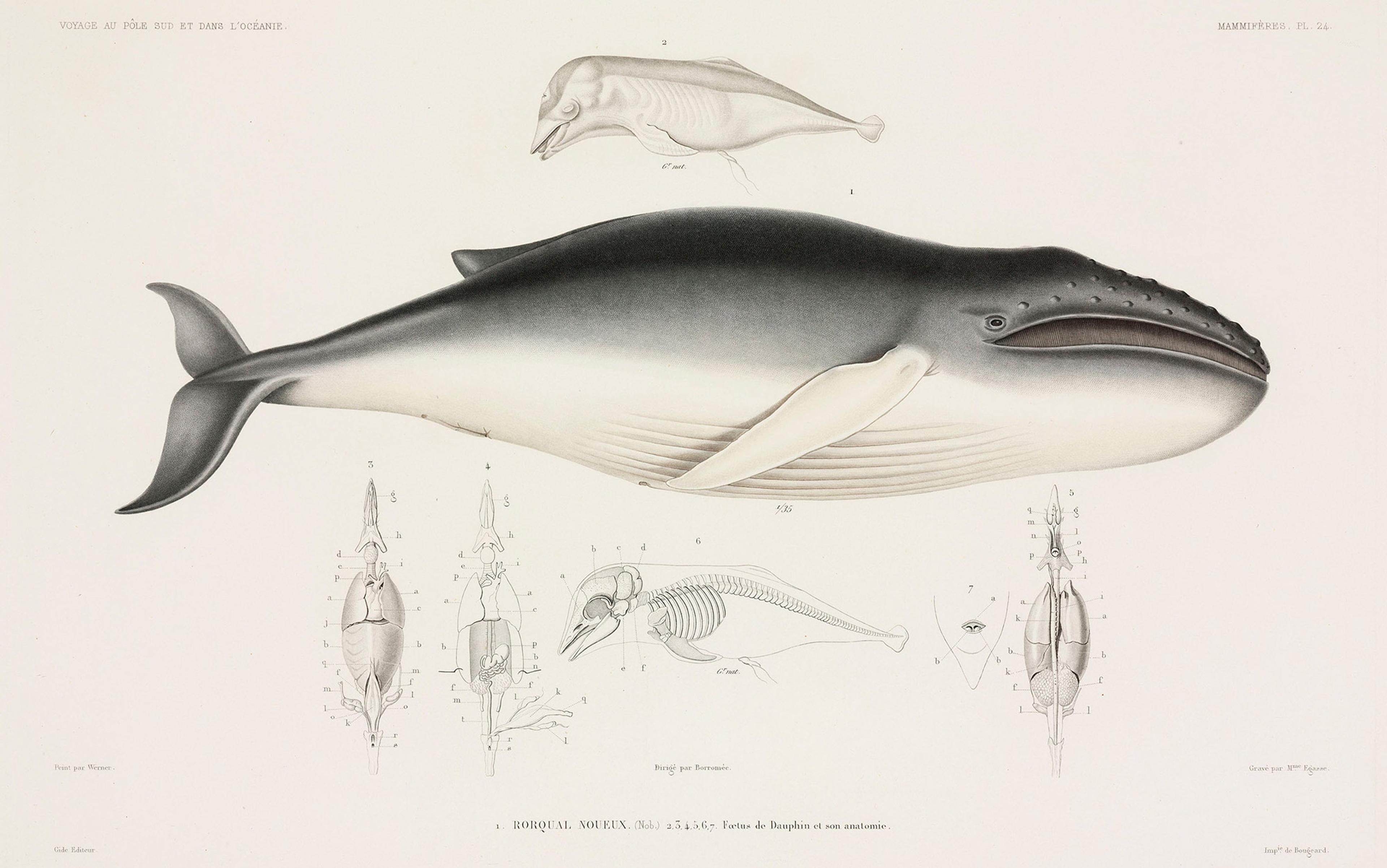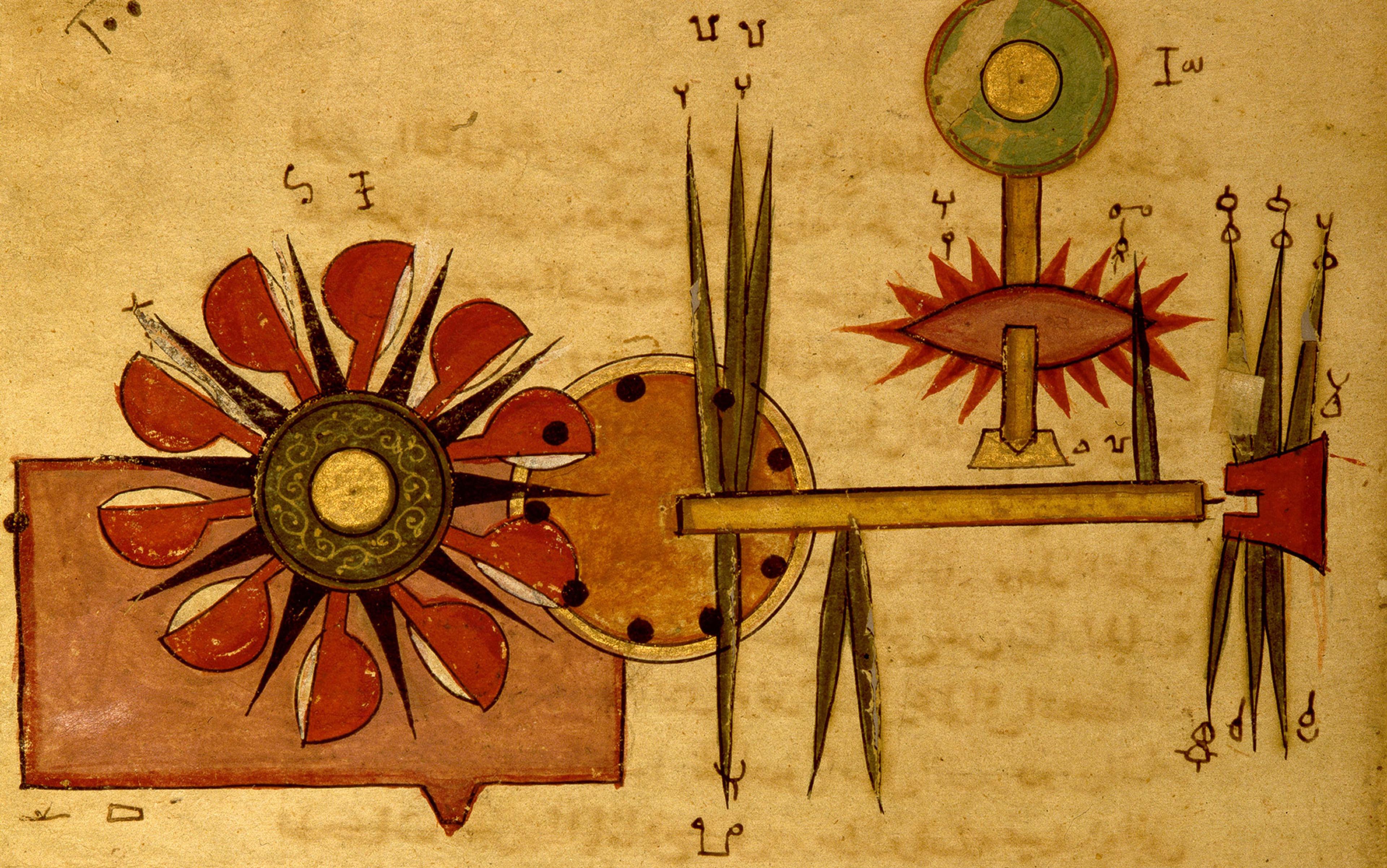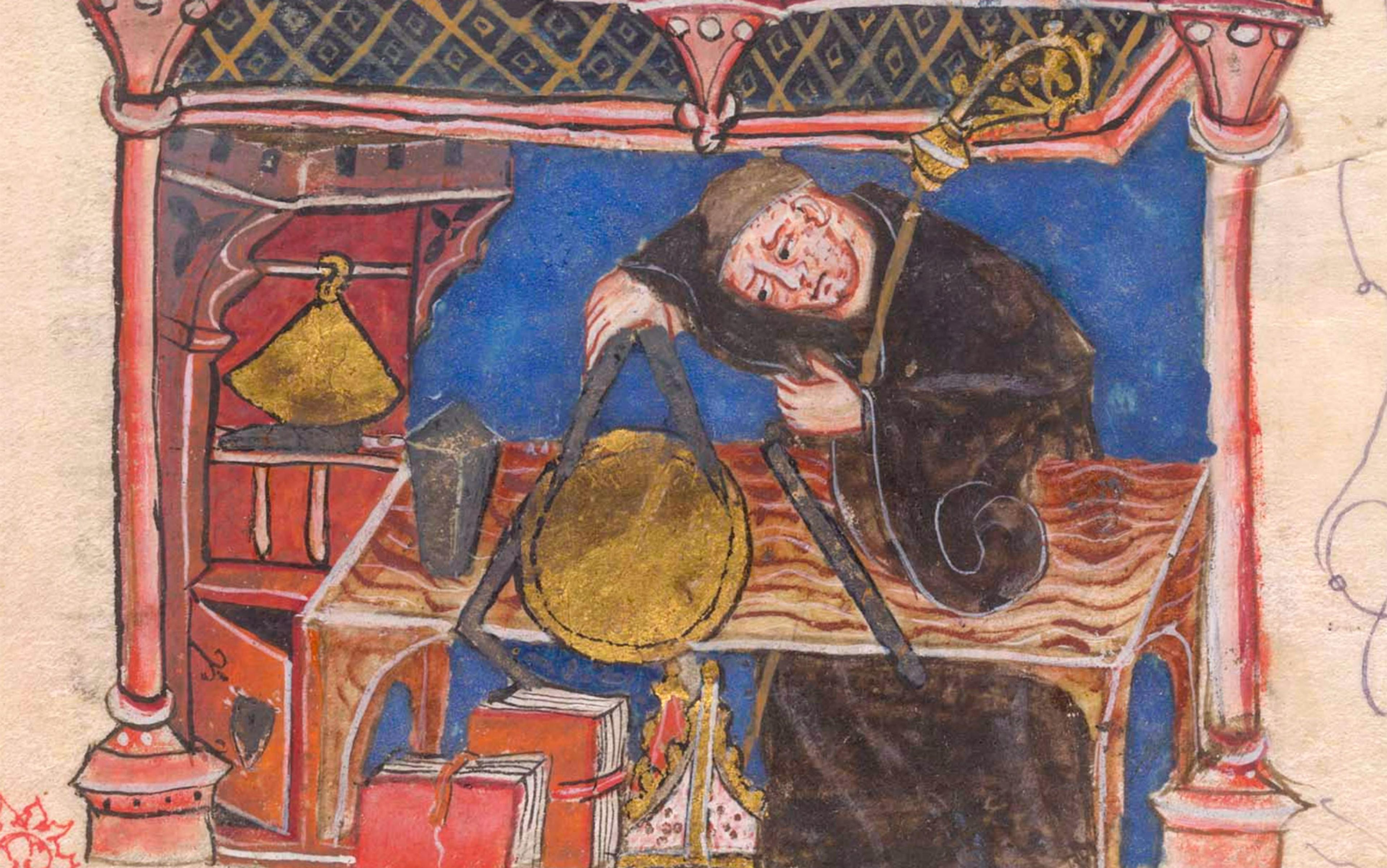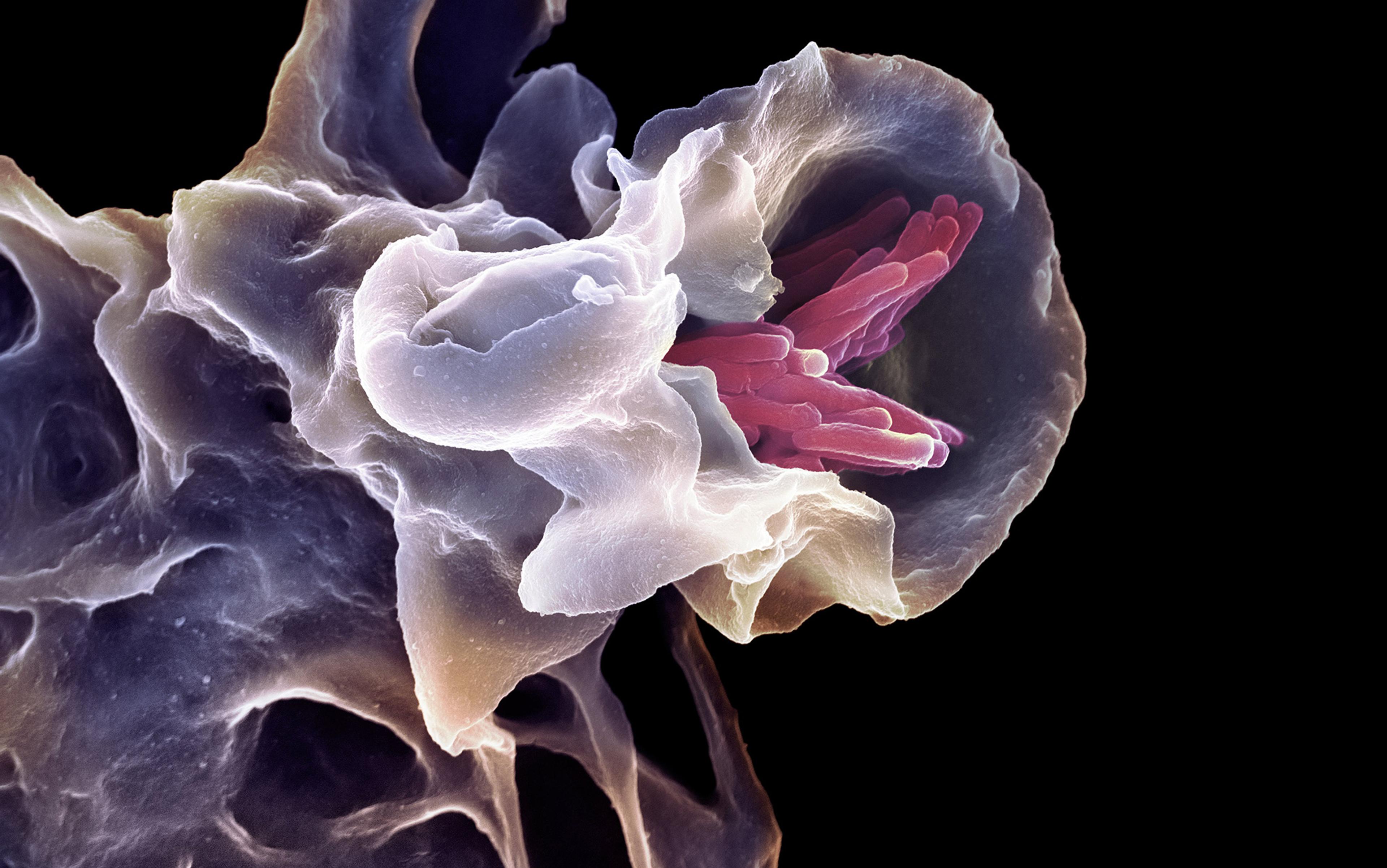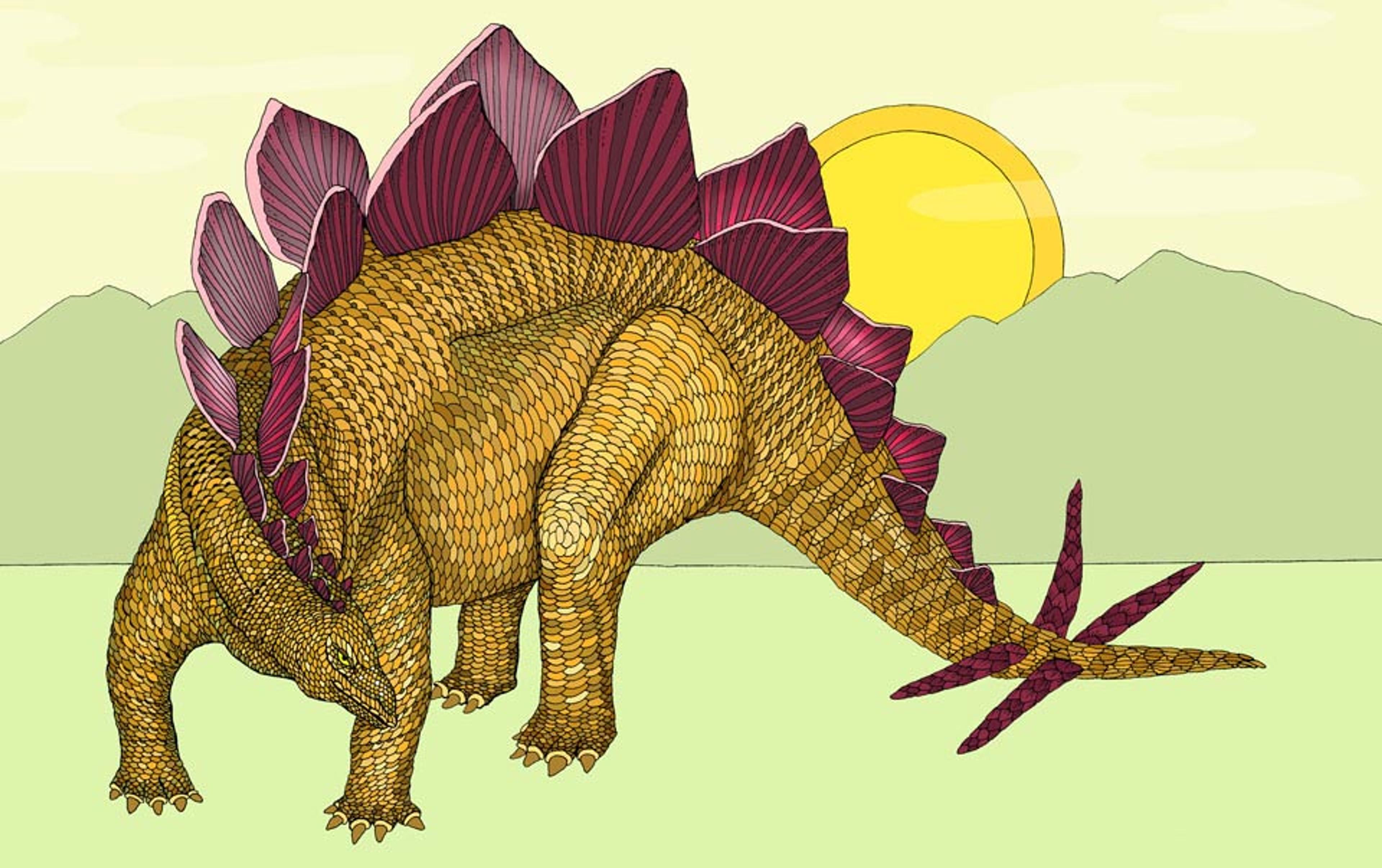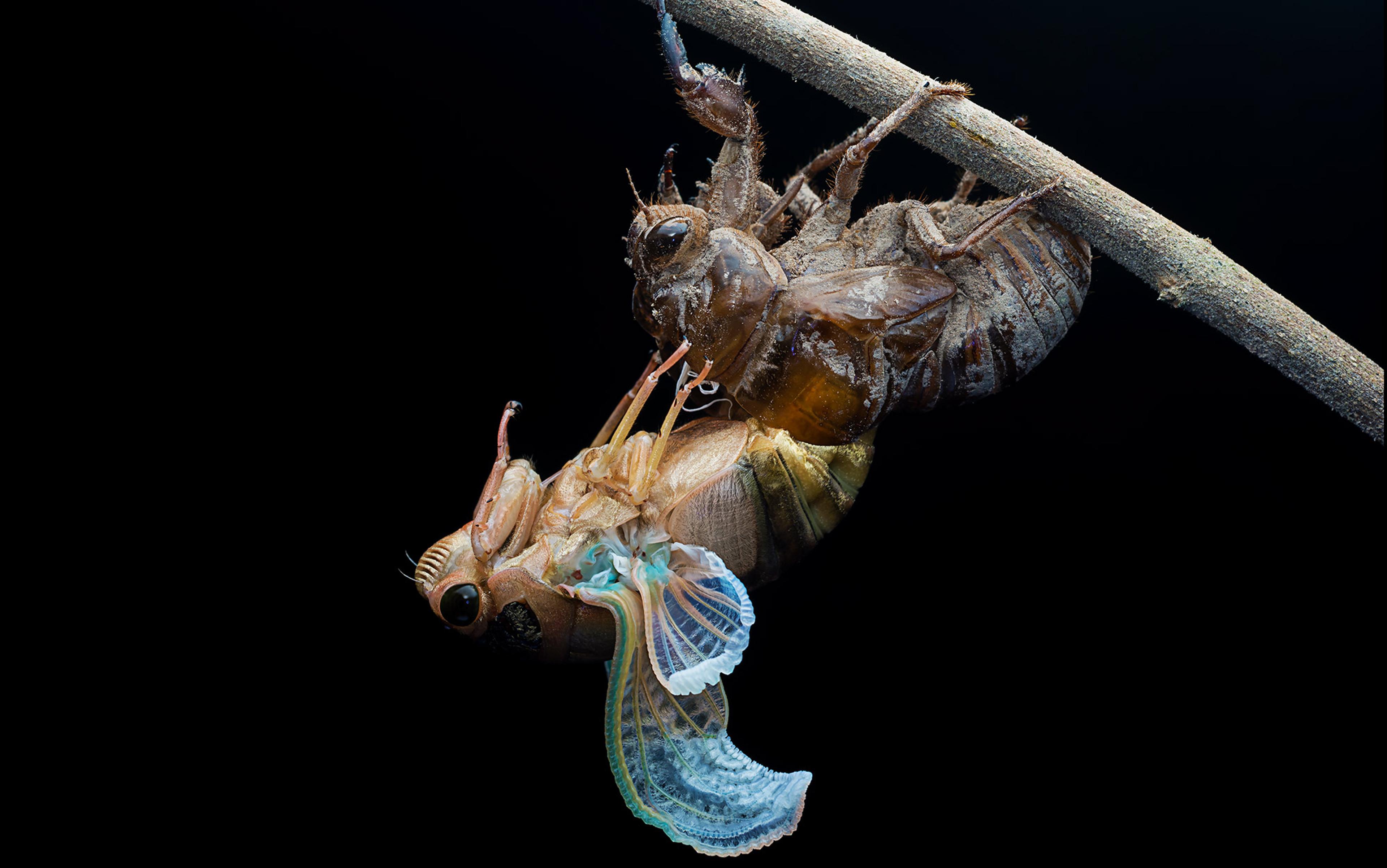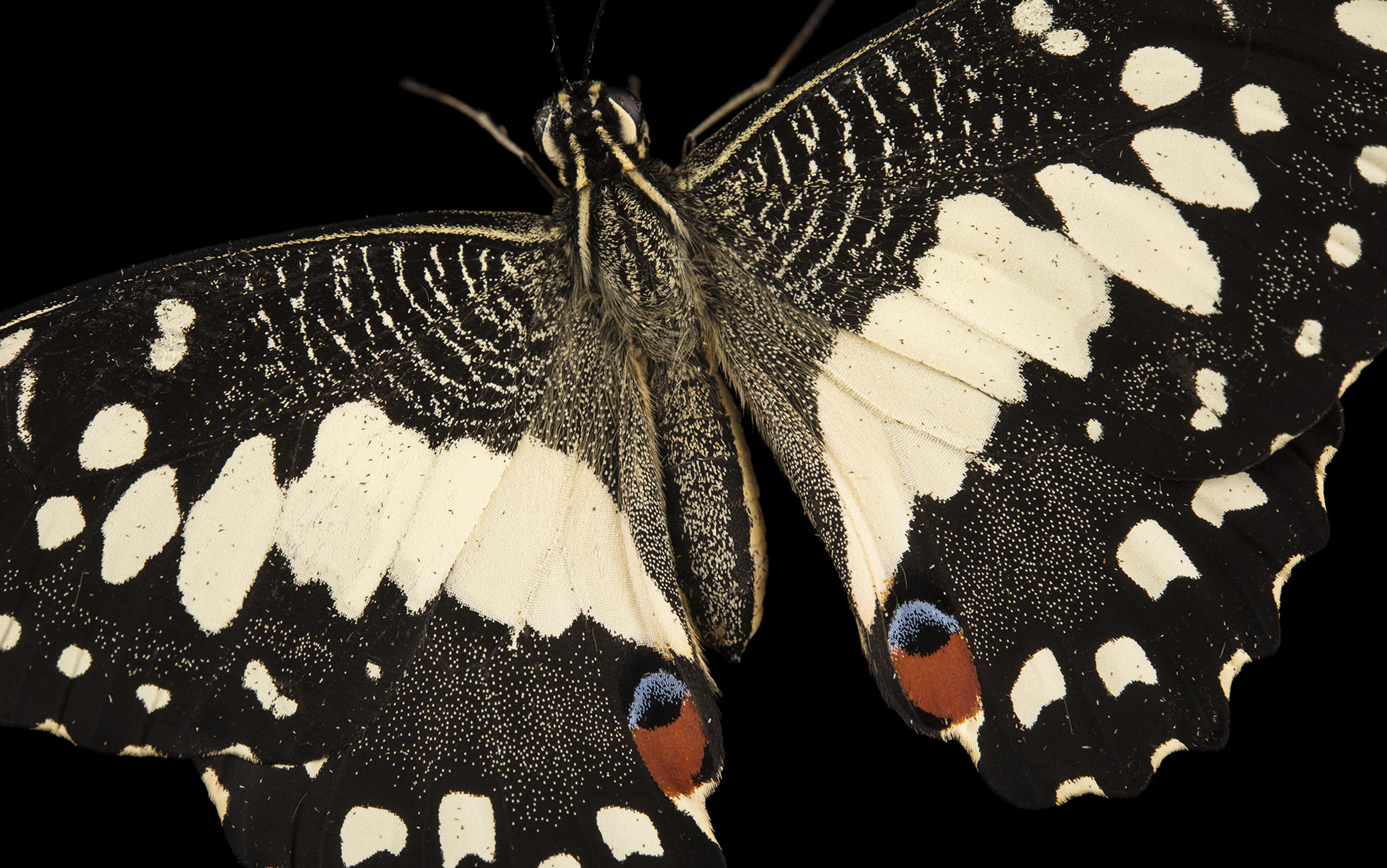The philosopher René Descartes, who lived for a time near the royal gardens of St Germain-en-Laye just outside Paris, was intrigued by the strange machines installed there. The grounds of the château were abuzz with water-powered automata that cavorted in grottoes, enacting scenes from Greek mythology and playfully splashing their visitors. If these intricate hydraulic mechanisms could perform the defining actions of living things – moving themselves, engaging, interacting – why shouldn’t living things and even human beings be a kind of machinery? ‘I suppose the body to be nothing but a statue or machine made of earth,’ Descartes wrote in Treatise on Man (1633), where he invoked the ‘clocks, artificial fountains, mills, and other such machines which, although only man-made, have the power to move of their own accord’.
At the time, Europe was humming with mechanical vitality. On the grounds of palaces and wealthy estates, 16th- and 17th-century Europeans built theme parks featuring puckish androids that chased after or hid from guests, sprayed them with water, flour or ash, made faces and sang songs. In churches and cathedrals, automaton angels sang and prayed; horrible devils rolled their eyes and flailed their wings; the Holy Father made gestures of benediction; and mechanical Christs grimaced on the cross as Virgins ascended Heavenwards.
The model of nature as a complex, clockwork mechanism has been central to modern science ever since the 17th century. It continues to appear regularly throughout the sciences, from quantum mechanics to evolutionary biology. But for Descartes and his contemporaries, ‘mechanism’ did not signify the sort of inert, regular, predictable functioning that the word connotes today. Instead, it often suggested the very opposite: responsiveness, engagement, caprice. Yet over the course of the 17th century, the idea of machinery narrowed into something passive, without agency or force of its own life. The earlier notion of active, responsive mechanism largely gave way to a new, brute mechanism.
Brute mechanism first developed as part of the ‘argument from design’, in which theologians found evidence for the existence of God in the rational design of nature, and therefore began treating nature as an artefact. The natural world of late-medieval and early Renaissance Europe had contained its own spirits and agencies; but arguments from design evacuated these to a location decisively outside the physical realm – leaving a fundamentally passive machinery behind. Since theology and natural science were not yet distinct fields of inquiry, brute mechanist ideas pervaded both. Between the mid-17th and early 19th centuries, the principle of passive matter became a foundational axiom in science, to the point that few people today recall its theological origins.
A key moment in the establishment of brute mechanism in science took place one Sunday evening in Edinburgh, in November 1868. The English naturalist Thomas Henry Huxley – friend and defender of Charles Darwin, as well as a professor of natural history, anatomy and physiology – gave a lecture. He chose the subject of protoplasm, or, as he defined it for the uninitiated, ‘the physical basis of life’. Huxley’s main point was simple: we should be able to understand what brings something to life simply by reducing it to its component parts. There should be no need to invoke any special something, any force or power such as ‘vitality’. After all, Huxley quipped, water has extraordinary properties too; but we needn’t rely on something called ‘aquosity’ to explain how hydrogen and oxygen produce water under certain conditions. To be sure, Huxley couldn’t say how the properties of either protoplasm or water arose from their composition; but he was confident that science would find its way to the answer, as clearly as ‘we are now able to deduce the operations of a watch from the form of its parts and the manner in which they are put together’.
Huxley’s lecture was a huge hit. Several editions of the periodical in which it appeared sold out straight away, with the editor enthusing that no article had ever ‘excited so profound a sensation’. Almost a century and a half later, Huxley’s quip about aquosity reappears regularly in biology textbooks and works of popular science. Yet despite the general triumph of the brute mechanist view of nature, there has also been a long line of dissenters. While brute mechanists were busy evacuating perception and agency from nature, there were still those who struggled to hold matter, feeling and will together: to keep the machinery alive. Their model can be hard to discern through the distorting acoustics of the latter 18th and 19th centuries, but these holdouts certainly had something very different in mind when they talked about the ‘clockwork cosmos’ or the ‘animal-machine’. We might call it active mechanism: the belief that agency is an essential and ineradicable part of nature.
Take William Harvey, the early modern English physician who first described the heart as a hydraulic pump. A great many things in animal bodies happened in a certain order in animal bodies, he observed, ‘in the same way as we see one wheel moving another in automata, and other pieces of mechanism’. But, wrote Harvey in 1651, the parts of the mechanism were not simply moving in the sense of changing position, as some natural philosophers had claimed. Rather, the parts were remaining in place, but transforming ‘in hardness, softness, colour’. Animals, he thought, were like automata made of changing parts: expanding and contracting in response to heat and cold, imagination and sensation and ideas. Elsewhere, Harvey likened bodies to church organs, an analogy that would become commonplace by the end of the century. Later, people used the comparison to imply that bodies were complex systems of interacting parts; however, Harvey meant that the muscles performed their actions by ‘harmony and rhythm’, a kind of ‘silent music’.
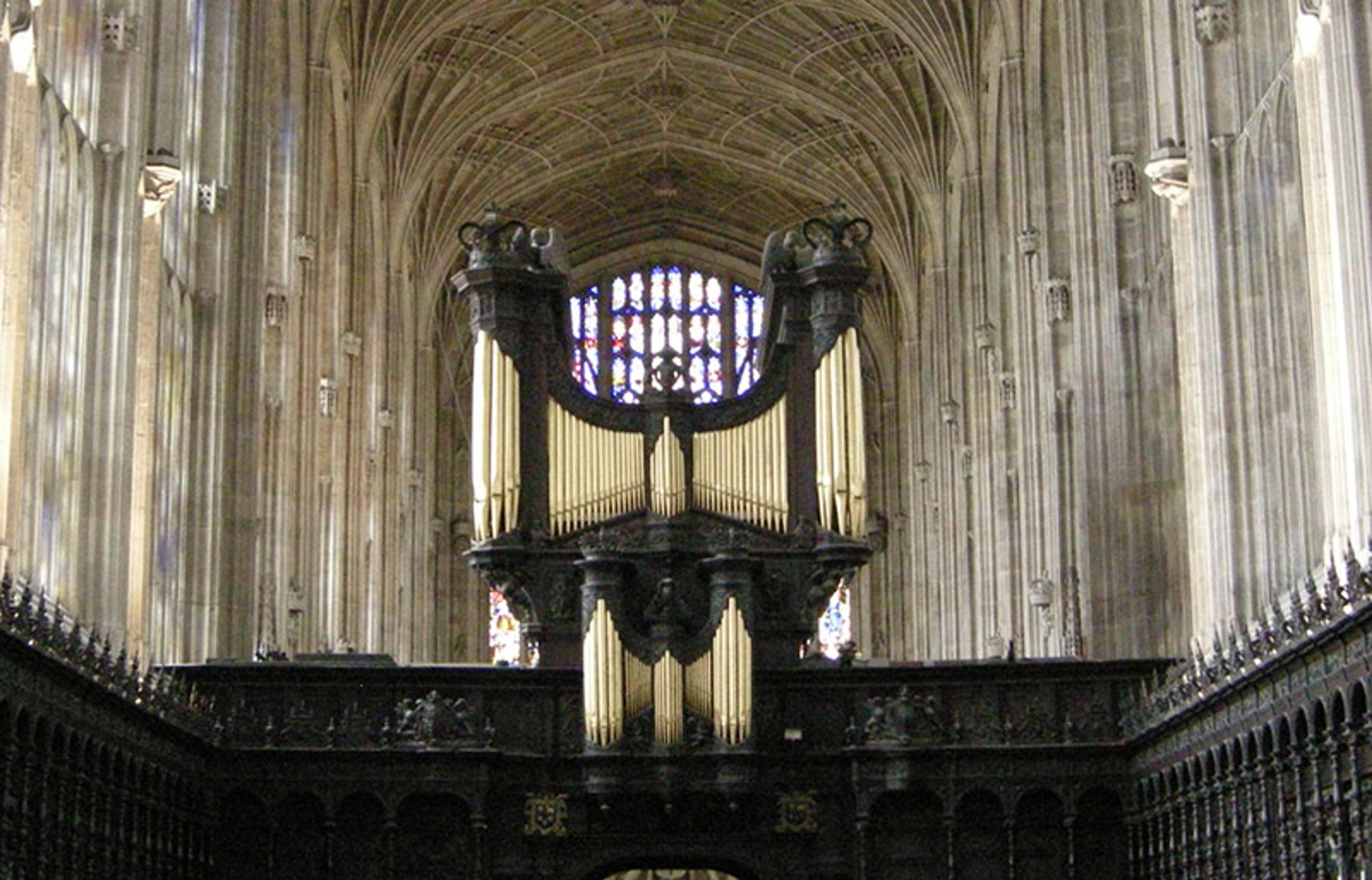
The organ at Kings College Chapel, England, Cambridge. Courtesy Wikimedia.
Mundane elements, Harvey thought, were capable of acting so as to transcend their own limits. Observing the emergence of life in a chicken embryo, he described a tiny point of blood that flickered in and out of existence: ‘betwixt the visible and the invisible, betwixt being and not being, as it were, it gave by its pulses a kind of representation of the commencement of life’. Likewise, the wind and ocean wafting navies around the globe; the pulley lifting a load; the compass pointing north; the fire forging iron – all this was accomplished by ordinary matter that ‘exceeded its own proper powers in action’. Harvey’s idea of mechanism was not passive or reductive but elevating: when he said that muscles worked mechanically, he meant that they could transcend the hierarchy of material nature in action, like a pulley lifting things much weightier than itself.
Harvey’s notion of mechanism was quite particular; for example, he distinguished his own mechanist view of animal generation from Aristotle’s. In his History of Animals, Aristotle had proposed that embryos, for example, arose from a kind of contagion – ‘a vital virus’ with which the sperm infected the egg. But this raised the problem of action at a distance: when the virus disappeared after the initial moment of contact, how did the process continue? How could a nonentity continue to act? Aristotle had invoked automata – suggesting that the initial contact at conception set off a succession of linked motions in the embryo, like the moving levers of a puppet. But Harvey rejected this explanation. Instead of comparing the uterus to a puppet or android, he compared it to the brain. Both, after all, formed ‘conceptions’. A brain produced works of art by bringing an immaterial idea to matter; maybe a uterus worked in a similar way, Harvey said. Just as the form of a house existed in the brain of the builder, maybe the form of an embryo existed in the uterus of the mother; just as education allows the mind to conceive ideas, maybe the moment of insemination endowed the uterus with the ability to conceive embryos. Once the seed disappeared, it is no longer needed to act: it was the uterus itself that took over the task of bringing a form to flesh, solving the problem of action at a distance.
The ‘soul of a brute’, he wrote, was like a ‘water organ’
Like Harvey, when Thomas Willis looked at machines, he did not see passivity. Willis was another English doctor, and a cartographer of the brain and nervous system. He disliked Descartes’s account of animals as automata, but did not reject the idea of living things as machinery in itself. Rather, Willis took Descartes to mean that animals were purely passive, moving only when set in motion by something from the outside. For his part, Willis preferred the idea of a ‘self-moving’, active animal-machine. (Descartes himself, as we have seen, considered machines to be engaging, capricious, responsive. But by the end of the 17th century, most people nevertheless construed Descartes’s ideas about animals the way that Willis did.)
Willis believed that animals’ souls were fully material, like the body, but were made from the choicest particles, the most ‘subtle and highly active’. These ‘nimble’ particles directed how the animal body would form and develop, gathering together in ‘turgid’ heaps, jostling, stirring and steering one another and the grosser particles into their proper places. Willis’s animal soul had physical parts and members, ‘pipes and other machines’, and this rigorously material entity was ‘knowing and active’, even capable of learning. It moved like ‘a blast of wind’ in an air-powered machine, running ‘hither and thither’ and producing all the animal’s sensations and movements.
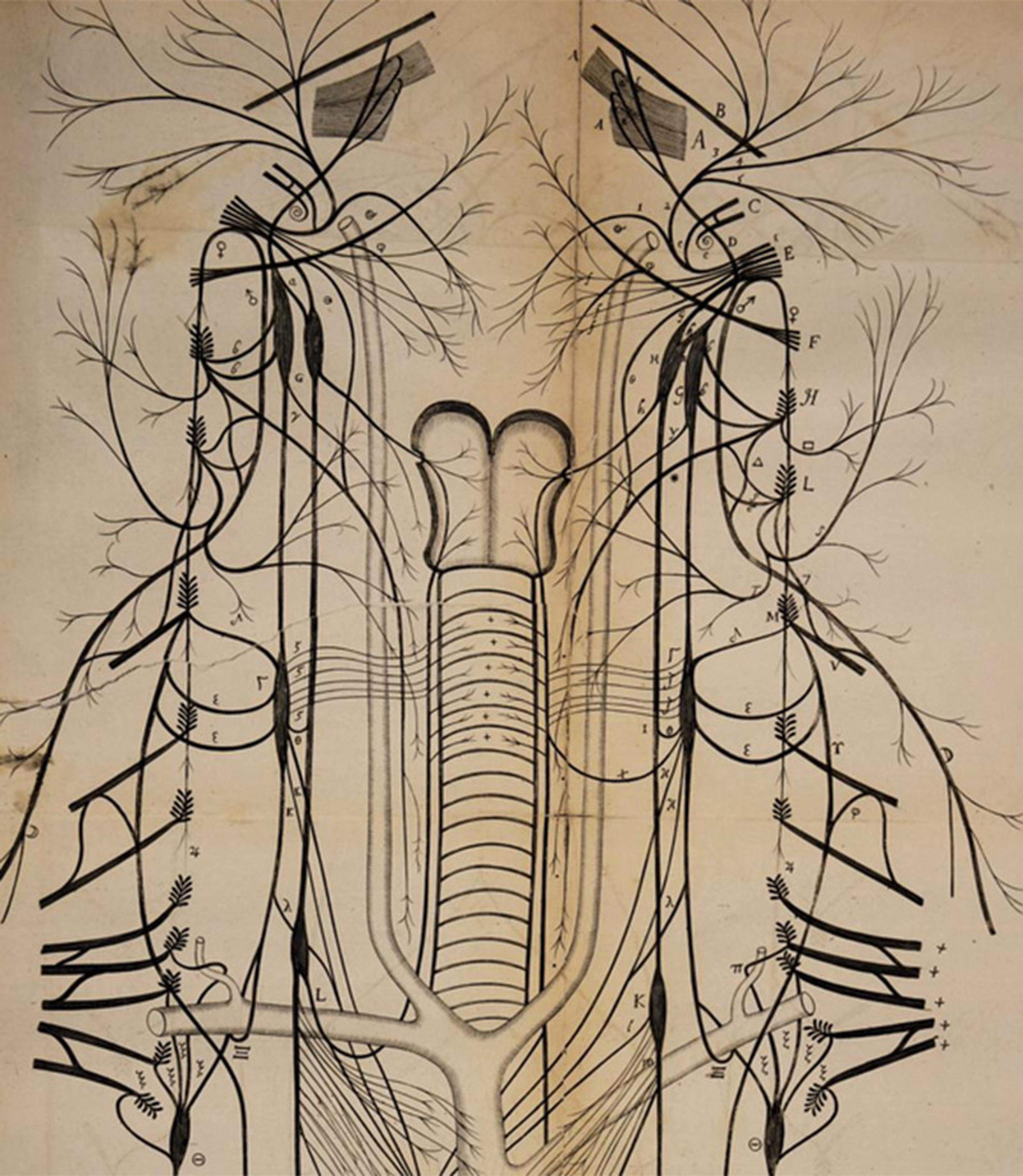
Detail of the nerves of the trunk from Cerebri Anatome 1664 by Thomas Willis. Courtesy Archive.org
Willis went well beyond the clockmaker’s assemblage of wheels and gears – which was, after all, only one narrow domain in the growing range of human-made devices. His drawing of the nerves of the human trunk strikingly resembles an organ. The ‘soul of a brute’, he wrote, was like a ‘water organ’: it could play only a limited repertoire of tunes, but in doing so, it could actively ‘institute, for ends necessary for itself, many series of actions’.
In the 17th century, then, plenty of people understood machines as things with parts that were intrinsically active. The German philosopher Gottfried Leibniz maintained this line, even as brute mechanism was in the ascendant. Leibniz’s great objection to Newtonian physics, for example, was that Newton described the cosmos as a passive mechanical device – and like any such mechanism, it required its maker to step in and adjust it, to rewind it and keep it ticking. The running of Newton’s cosmic clock, therefore, rested upon an extra-natural cause, an actor intervening from outside the system. To Leibniz, that seemed like both bad theology and bad science.
A major problem with philosophies of passive mechanism, Leibniz argued in 1714, was that they could never account for the mind. To demonstrate his point, Leibniz asked his reader to imagine a big machine, the size of a mill, that could think, feel and perceive. Imagine walking into this great factory and looking around. You would understand consciousness no better than before walking into this mill of the mind. Examining the machinery, the moving parts, you would see only ‘pieces that push each other and never anything to explain a perception’. You would know immediately that perception and consciousness were something other than that. Perception, Leibniz concluded, was not an outcome of the operation of a mechanism, but resided in its very substance.
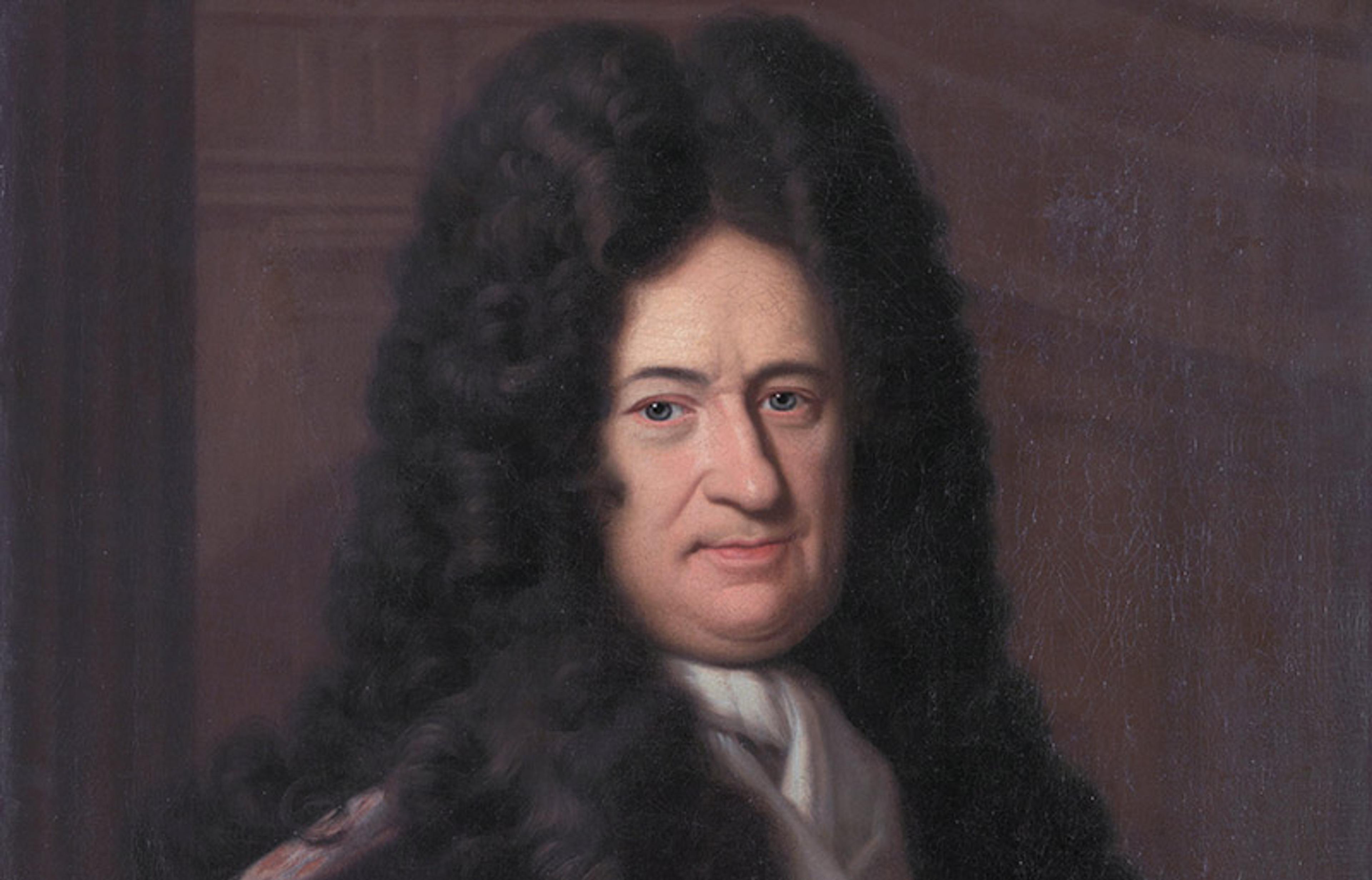
Portrait of Gottfried Wilhelm Leibniz c1695 by Bernhard Christoph Francke. Courtesy Herzog Anton Ulrich Museum /Wikipedia.
Leibniz in fact argued that brute mechanism was not just inadequate as a way to understand animals – it was not even a good description of machines. Descartes’s version of clockwork was implausible as an account of a clock, let alone of a dog. For Leibniz, nothing lacked a soul: matter drained of spirit could explain nothing. Mechanics required something more: namely, force, energy, modes of action.
Newton’s cosmic clock rested on an extra-natural cause, an actor intervening to rewind it
In the 1680s and ’90s, Leibniz defended these ideas in heated debates with Cartesians about the nature of motion and force. The basic puzzle concerned why things in the world moved: where did this force come from? Leibniz said that the theory of an ‘Archaeus’, a nebulous spirit that suffused the material world, was ‘unintelligible’. But he also rejected the tendency among the authors of standard mechanical philosophy to ‘summon God ex machina’, and withdraw all force from matter itself. That would require an absurdity: for God to be a puppeteer, such that ‘when a person thinks and tries to move his arm, God moves the arm for him’.
Granted, brute mechanists had ‘purged inexplicable chimeras from philosophy’, Leibniz said. But they paid too high a price. They had simply exported the chimera, leaving a metaphysical gap occupied by a meddlesome deity. ‘I tried to fill this gap,’ Leibniz wrote. Instead of evacuating force from matter, he proposed a third way: a fully mechanist account of nature in which ‘living force’ was intrinsic to the substance of the world. Leibniz’s philosophical purpose was to forge a single system encompassing all of nature, with nothing outsourced, nothing rendered exceptional or external. This vis viva or ‘living force’ was present in every material event, like ‘a flare that runs the length of a cord or a fluid that runs in a channel’. When he called a process ‘mechanical’, Leibniz didn’t mean that it was drained of liveliness and vitality. Rather, he meant that the process followed from its own internal principles, with no appeal to a deus ex machina. This naturalised form or agency became a model for an alternative approach to physics and engineering, culminating in the influential concepts of energy and work in the 18th and 19th centuries.
Over his career, Leibniz developed an increasingly distinct understanding of the mechanism of nature. In the Monadology (1714), he reasoned that the most basic elements of the world could not be material, because any corporeal entity – no matter how ‘invincibly attached’ – must be divisible. One could always imagine dividing it further, so the indivisible atoms that made up the world must be something else. Descartes had defined the elements of the physical world as bits of stuff with ‘extension’ in space; Leibniz proposed instead that they were bits of spirit, endowed with perception. The most basic elements of the world, according to Leibniz, were perceiving souls or ‘monads’.
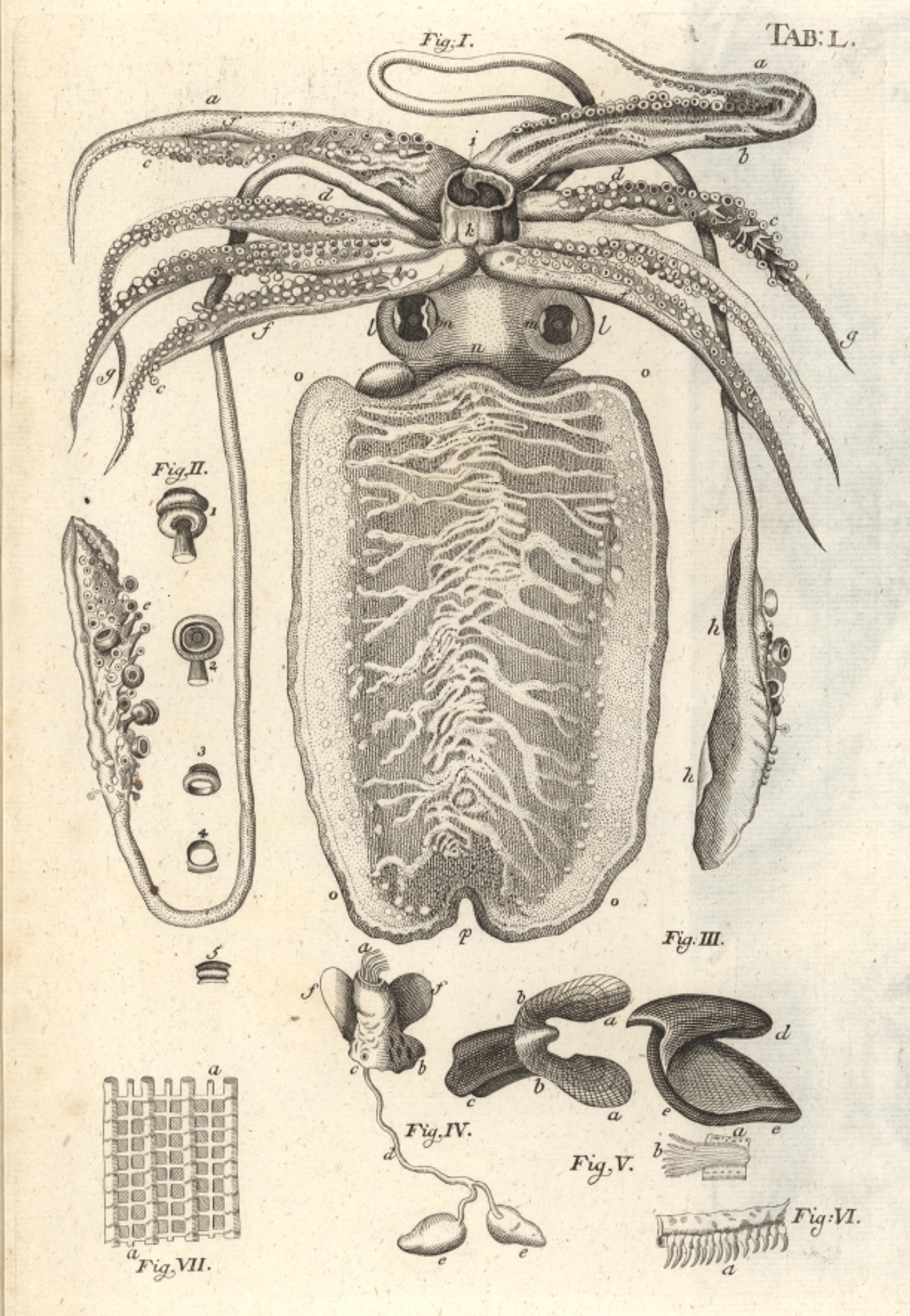
From Jan Swammerdam’s Bible of Nature 1752. Courtesy Paul K. /Flickr.
By substituting perception for extension, Leibniz flipped materialism on its head. Instead of a reduction of spirit to matter, he reduced matter to spirit, with tiny, perceiving monads in the place of inert, physical chunks. This picture had a certain majesty. The cosmos and everything within it, including animals and humans, was a great nesting of machines within machines within machines, all built from little sensing spirits. Unlike artificial devices, which could be reduced to simple parts, living nature for Leibniz was machinery all the way down. ‘I define the Organism, or the natural Machine,’ he wrote in 1704, as ‘a machine in which each part is a machine, and consequently the subtlety of its artifice goes to infinity.’
Leibniz developed these ideas with inspiration from the natural sciences of his day. In 1676, during a trip to the Netherlands, he met the Dutch microscopists Johannes Swammerdam and Antonie van Leeuwenhoek. Swammerdam had described how a cuttlefish sperm, upon being removed from the gonad, began to act on its own. The self-directed movements of this ‘minute machine’ were not ticks and tocks but twists and turns, evolutions, unfoldings, emergences. ‘The extremity begins to evolute and unfold itself,’ Swammerdam wrote in The Book of Nature (1676-9), ‘and the two slender ligaments, which emerge out of the case, turn and twist themselves in various directions.’ Informed by these experiences, Leibniz described the living body as ‘a sort of world full of an infinity of creatures who also deserved to exist’. Each speck was a garden of plants, each drop a pond teeming with fish. Every part of every plant or animal and all the air between them was lush with living creatures. ‘All of nature,’ Leibniz wrote in the essay ‘The Principles of Nature and of Grace, Based on Reason’ (1714), ‘is full of life’ – precisely as full of life, in fact, as it was of mechanism.
‘Unruhe means disquiet: a model of how it is in our bodies, which can never be perfectly at their ease’
What Leibniz meant by ‘machinery’, then, was not just different from, but directly opposed to what most other mechanists meant. When Leibniz wrote that the bodies of men and animals were ‘no less mechanical’ than watches, he meant something profoundly different from the same statement made by followers of, say, Descartes or Robert Boyle. There was no pushing and pulling for Leibniz, no action by impact – only the appearance of these mechanical causes. Matter itself was an appearance, a secondary effect of the perceptual substance of which the world was composed. Monads could not change one another, having no extension, no parts – no ‘windows’, as Leibniz put it, through which anything could come in or go out. Rather, each little soul followed its own internally directed sequence of changes that had been set in motion at the beginning of time, while a ‘pre-established harmony’ coordinated all these sequences in order to follow the laws of mechanics.
In German, Leibniz explained, ‘the word for the balance of a clock is Unruhe – which also means disquiet; and one can take that for a model of how it is in our bodies, which can never be perfectly at their ease.’ In Leibniz’s view, bodies and clocks alike were disquiet, uneasy, ever-responsive, restless things.
Active and passive mechanism jostled for primacy in the life sciences throughout the 18th century and into the 19th. This struggle was extremely productive. By the end of the 18th century, active mechanist philosophy had generated the first theories of species change. Because order came from within for active mechanists, rather than being delivered all at once and from the outside, it became important to imagine how organised features of the natural world might have emerged over time – not as a static structure, but a patterned process.
Yet brute mechanism continued its onward march. William Paley, a Christian philosopher active in the late-18th and early 19th centuries, represents passive mechanism at its most influential. Paley defended the idea of a designer-God using the analogy of a watch on the heath. If you tripped over a stone while you were out walking, he said, you might suppose it had always just been there. But if you tripped over a watch, you could hardly make the same supposition. So the beautiful, living clockwork of nature must point to the presence of a divine watchmaker. But Paley’s argument assumes that the watch is as passive as a stone, lying on the heath waiting to be kicked aside; a moving, self-constituting and self-transforming watch would imply something else entirely.
Today, the tension between active and passive mechanism is still evident, for example, in evolutionary biology. While evolutionary theorists reject creationism, of course, concepts such as adaptation and fitness are in fact grounded in a passive-mechanist view of living structures. That view has traditionally banned any talk of evolutionary agency within living organisms, and instead ascribed their forms and structures to forces acting from outside them.
At the same time, evolutionary theory retains an important inheritance from the active mechanist tradition; indeed, active mechanist ideas seem currently to be in the ascendant. Recent work on ‘niche construction’ for example attends to the ways that organisms can shape their environments, which in turn shape them through natural selection. Meanwhile, research in epigenetics examines how organisms can transform in response to their environments in heritable ways. Rather than being purely passive recipients of environmental pressures, organisms are active and self-transforming, according to current research.
According to these scientists, life is still fundamentally mechanistic – in the sense that it is made of mechanical parts and forces, with no spirits or supernatural puppeteers to make it go. But if living things are machines, they are looking more and more like responsive and disquiet ones, in a perpetual state of flux and restlessness.
Adapted with permission from The Restless Clock by Jessica Riskin, published by the University of Chicago Press. © 2016 by The University of Chicago. All rights reserved.
